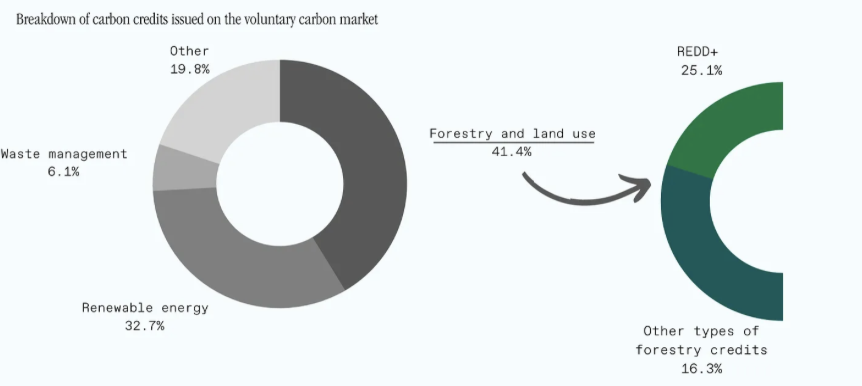Breaking down REDD+: definitions and issues


· 5 min read
This article is part of illuminem's Carbon Academy, the ultimate free and comprehensive guide on key carbon concepts
REDD+ (Reducing Emissions from Deforestation and Forest Degradation) is a type of avoidance/reduction carbon offset aimed at mitigating climate change by addressing deforestation and forest degradation in developing countries. REDD+ is one of the main nature-based solutions aimed at reducing carbon dioxide emissions and the credits produced from REDD projects are traded in the Voluntary Carbon Market.
One of the key objectives of REDD+ is to promote sustainable forest management practices that enhance carbon sequestration, biodiversity conservation, and community livelihoods.
Nature-based solutions (NBS) constitute the largest proportion of carbon credits available in the VCM. REDD+ stands out as the most significant project type within the nature-based project category. As of 2022, the volume of REDD credits issued on Voluntary Carbon Markets (VCMs) reached nearly 400 million, constituting a remarkable one-quarter of all voluntary credits ever issued. This underscores REDD+'s pivotal role as the single largest source of credits in terms of project type, as shown in the infographic below.

source: Berkeley Voluntary Registry Offsets Database, data up until November 2022
Let us now examine some of the main challenges and flaws that REDD+ projects may incur:
Jurisdictional REDD+ is emerging as a different approach to REDD+ initiatives. Jurisdictional REDD+ refers to an approach where efforts to reduce emissions and enhance carbon stocks are implemented at the jurisdictional level, typically within a political or administrative region like a state or province. Accounting, such as baselining and deforestation monitoring, is carried out on a national level. In this approach, the focus extends to all forests within an entire country or sub-national region. This comprehensive perspective makes it more challenging to overstate baseline deforestation figures, as the assessment encompasses all areas.
Achieving the goal of keeping global temperature below 1.5°C depends on a significant reduction of emissions coming from deforestation.The depletion of forests also poses significant threats to biodiversity and endangers the livelihoods of people who depend on forest resources.
In this context, REDD+ plays a crucial role, providing a market-based mechanism to mitigate climate change and serving as a more cost-effective alternative to tech-based solutions.
As with any other carbon offset project, the success of REDD+ and the consequent issuance of good quality credits rely on a combination of factors, ranging from effective policy frameworks to robust monitoring and reporting systems.
Are you a sustainability professional? Please subscribe to our weekly CSO Newsletter and Carbon Newsletter
Charlene Norman

Sustainable Business · Sustainable Finance
Giovanna Melandri

Ethical Governance · Environmental Sustainability
Lamé Verre

Corporate Social Responsibility · Social Responsibility
Associated Press

Climate Change · Environmental Sustainability
The Washington Post

Public Governance · Climate Change
The Wall Street Journal

Carbon Market · Corporate Governance